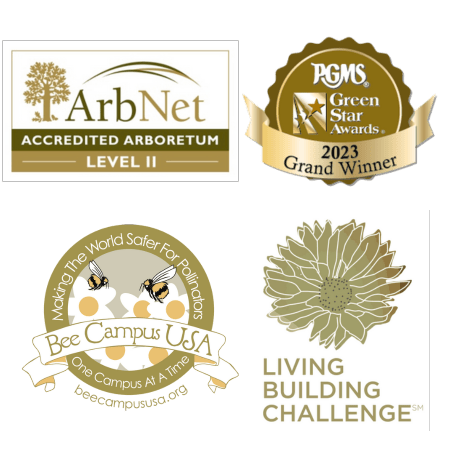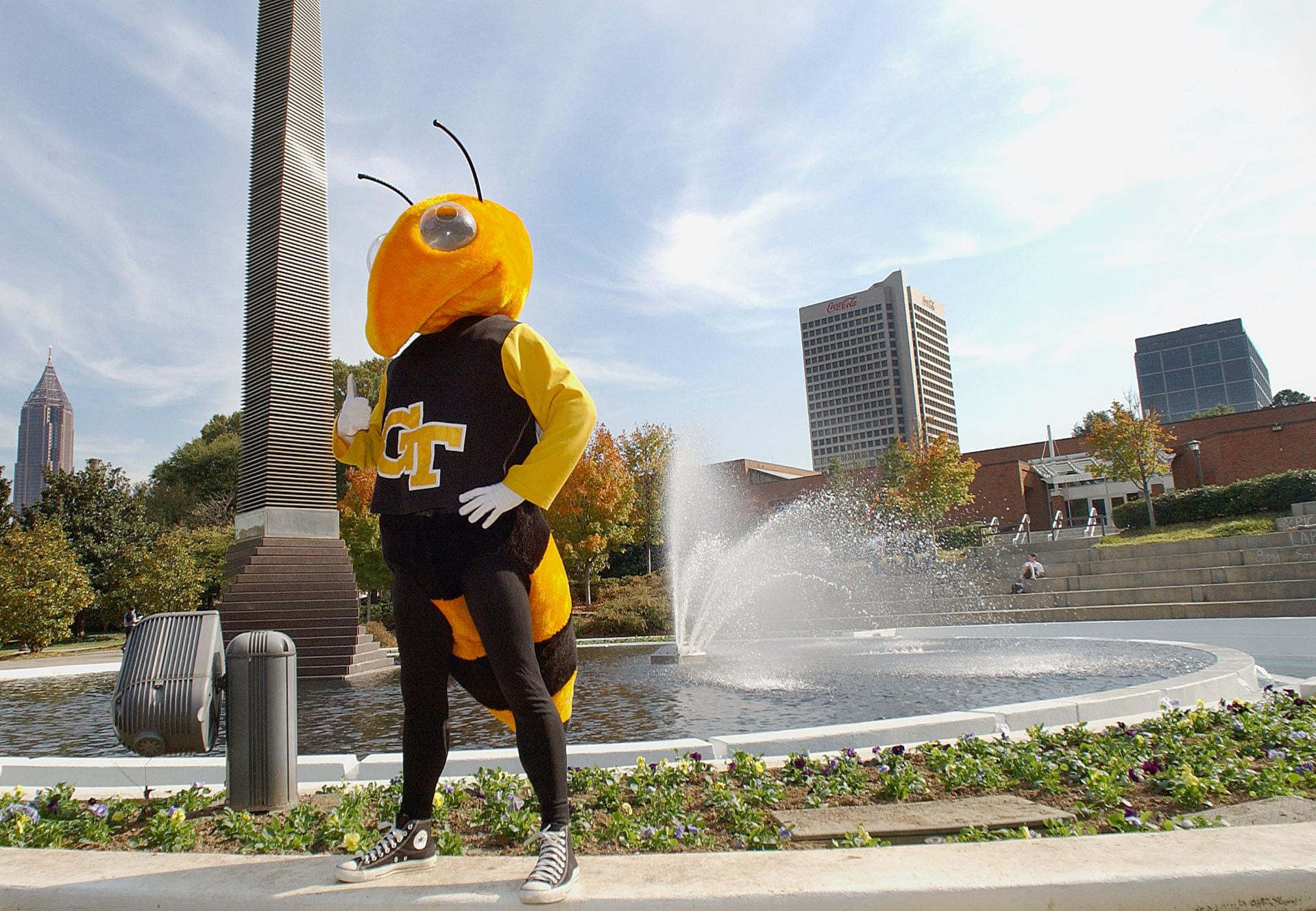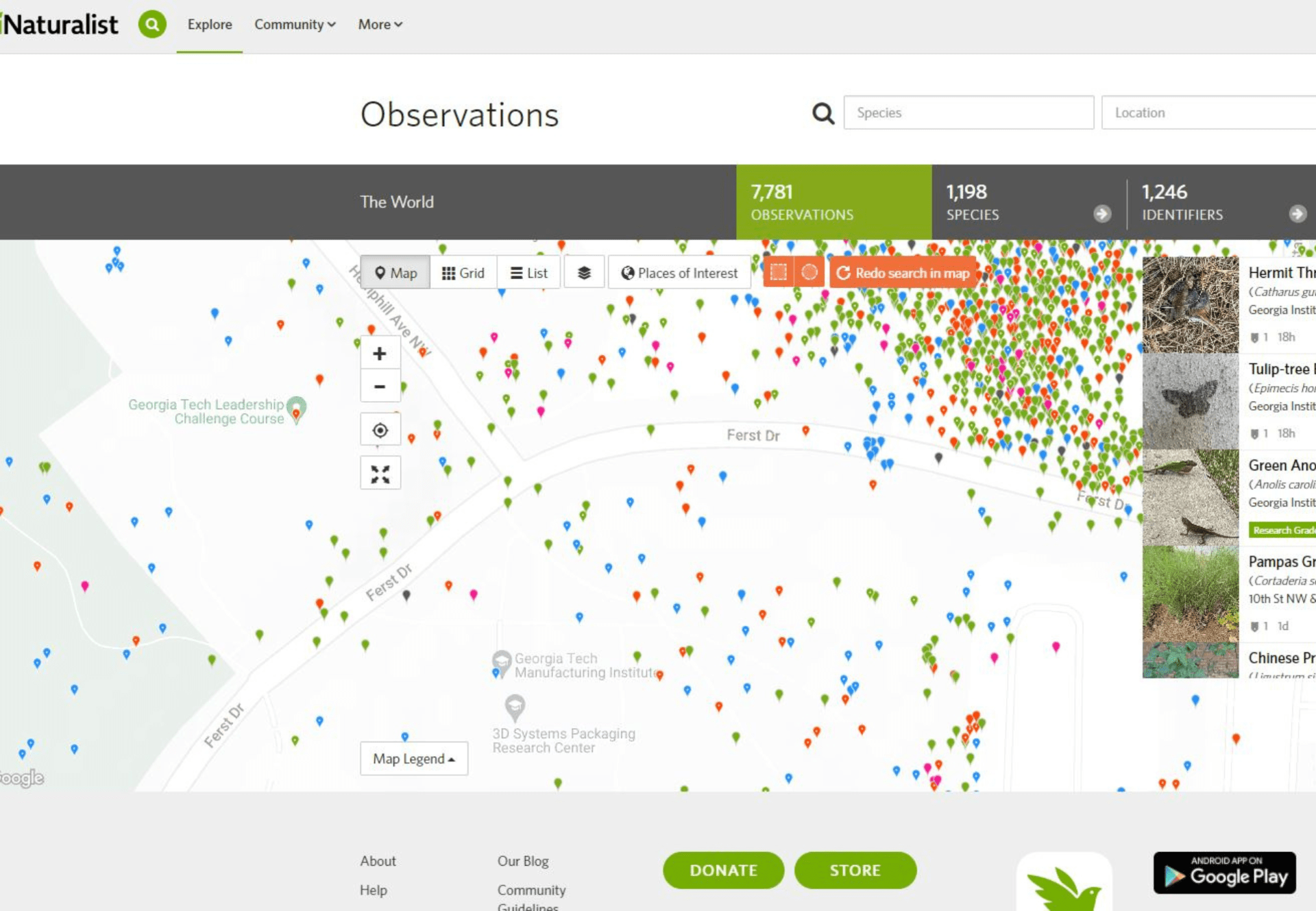Biodiversity at Georgia Tech
FY 2023 Landscape Data
Georgia Tech campus vegetation plays both an ecological and a design role. Sustainable use of vegetation at Georgia Tech is governed by ecological principles, site assessment, and interface with human use. The objective of Georgia Tech’s Integrated Pest Management (IPM) plan is to reduce the occurrence of pests while ensuring minimal human exposure to health risk and inflicting minimal hazards on the environment.
%
Tree Canopy Coverage
Acres Managed Organically
%
Sustainable Integrated Pest Management

Biodiversity Strategy
Increase Georgia Tech’s tree canopy coverage and biodiversity.

Carbon Sequestration Analysis
Carbon sequestration is the practice of capturing and storing atmospheric CO2, which is one of the main planet-warming greenhouse gases. The process of sequestration involves extracting CO2 from the atmosphere via photosynthesis, with a portion being stored in soil, plants, or trees. As a plant captures CO2, it emits oxygen into the atmosphere and synthesizes sugars by combining carbon and water. Natural carbon sinks are reservoirs that absorb and retain atmospheric carbon, such as forests, urban trees, soils, and oceans. Preserving and enhancing carbon sinks is an effective strategy for mitigating climate change by removing carbon dioxide from the atmosphere.
A Carbon Sequestration Analysis (CSA) measures how much carbon is absorbed and stored within a defined area. The CSA contributed the following results:
- Determined how much carbon Georgia Tech’s campus sequesters (gross removals of carbon) each year.
- Determined how much carbon Georgia Tech’s campus emits (gross emissions of carbon) each year.
- Determined the balance between emissions and removals (net carbon flux) each year.
- Converted net carbon to CO2e for comparison and inclusion in the GHG inventory.
- Informed decisions about how to manage Georgia Tech’s natural environment.
How It Works
Sequestration can occur in different “carbon pools” in an ecosystem. A carbon pool is a component of the Earth’s climate system that can store, accumulate, or release carbon. These pools include various natural reservoirs, such as oceans, soils, forests, and the atmosphere.
Collectively, the carbon stored in pools constitutes the carbon stock of the specified ecosystem, representing the total amount of carbon sequestered. This interplay between plants and soil forms a dynamic carbon sink.
- Soils: The ability of soils to sequester carbon depends on a range of factors, including soil type, fungi, organic matter content, and land management practices. Healthy soils can sequester carbon for centuries, acting as a natural buffer against climate change. Carbon sequestration involves complex interactions between plants, soil, and organisms.
- Fungi: Fungi play a vital role in carbon sequestration, breaking down organic matter in the soil and storing carbon in their tissues. Mycorrhizal fungi, in particular, form form symbiotic relationships with plants, helping them to absorb nutrients and water from the soil. In exchange, the plants provide the fungi with carbohydrates, which the fungi use to grow and store carbon.69
- Animals: Animals also contribute to carbon sequestration by consuming plants and storing carbon in their bodies, as well as dispersing seeds needed to spread carbon-sequestering vegetation.70
- Vegetation: Plants and trees play a continuous role in this cycle, absorbing carbon dioxide from the atmosphere and storing it within their tissues.
When trees and plants burn, are eaten, or when land undergoes changes from one cover type to another (such as transitioning from a forest to urban development), a portion of the stored carbon gets released back into the atmosphere. Trees and plants also naturally release some carbon through leaf senescence or other natural losses in biomass. The release of carbon in the atmosphere, often in the form of carbon dioxide, contributes to fluctuations in the ecosystem’s carbon stock. The annual change to the carbon stock is called the carbon flux. The CSA measured carbon flux from trees at Georgia Tech.
An Urban Forest
Georgia Tech’s home campus is located within Atlanta’s city limits, meaning the trees on campus contribute to the city’s overall canopy coverage. Trees are both a major feature of Atlanta’s landscape and a primary contributor to biological carbon sequestration on Georgia Tech’s campus. In 2023, Georgia Tech’s campus tree canopy coverage was 22%. It is an important part of the campus design, and plans are in place to continue preserving and expanding it. For example, the 2010 Campus Landscape Plan has a goal to expand canopy coverage to 55% of campus. In addition to beautifying the Tech campus, forests and trees have many co-benefits, including:
- Reducing the urban heat island effect.
- Reducing stormwater runoff.
- Reducing the amount of air pollution.
- Supporting biodiversity and pollinators.
- Sequestering carbon.
- Improving property values.
- Improving mental and physical health of surrounding communities.
Explore
EcoCommons
The overarching EcoCommons Project envisions 80 acres of green space across campus that aims to mimic a traditional piedmont woodland that follows what the original areas was before being urbanized. Most of the plants on the site are native to this region.
The Kendeda Building's Connection to Ecology
Previously a parking lot, the Kendeda Building site is now a restored natural area with native plants chosen for beauty, resilience, and attracting pollinators. Designed with the Living Building Challenge’s “Place Petal” in mind, it minimizes impact and fosters a nature connection.
STARS
Georgia Tech actively participates in the Sustainability Tracking, Assessment & Rating System (STARS) to benchmark its sustainability efforts. Learn more about biodiversity & land management at GT by exploring the credits below.
Campus Biodiversity
The GT Campus Biodiversity Survey is a project led by Emily Weigel, a senior academic professional in the School of Biological Sciences. It monitors biodiversity on campus by enabling the public to upload observations and identifications of species found around campus. The information is hosted on iNaturalist, a crowdsourced species identification system and an organism occurrence recording tool.


